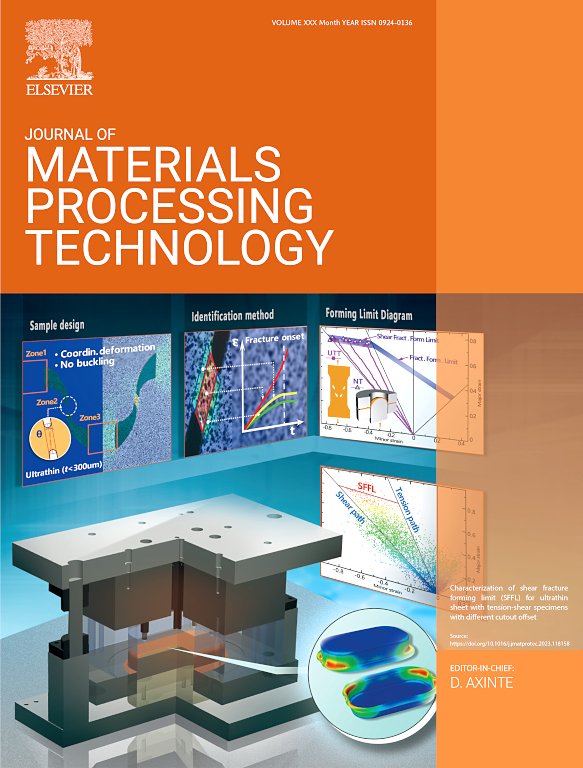使用简单标准预测金属箔的微/介质鳞片成形极限
IF 6.7
2区 材料科学
Q1 ENGINEERING, INDUSTRIAL
Journal of Materials Processing Technology
Pub Date : 2024-09-25
DOI:10.1016/j.jmatprotec.2024.118612
引用次数: 0
摘要
由于金属箔很容易出现缩颈失效,因此准确预测金属箔的成型极限对其微成型至关重要。为了准确、简便地预测受尺寸效应影响的金属箔成形极限,本文提出了一种利用金属箔的不同断裂模式与剪切带相关的机理建立金属箔失效模型的想法。基于这一想法,提出了一个简单的韧性破坏准则,该准则考虑了最大剪切应力和晶粒尺寸效应,但排除了应力三轴性,其动机是降低微成型破坏预测中参数计算试验的复杂性。应用所提出的准则和另一种称为μ-DF2022 模型的准则来捕捉不同晶粒尺寸的各种厚铜箔和 304 不锈钢箔的成形极限曲线,以验证其优势和性能,并阐明其预测能力的相应机制。此外,还应用提出的模型和 μ-DF2022 模型预测了 304 不锈钢箔的极限拉伸比,进一步显示了其在实际微成形中的性能和优势。应用结果表明,所提出的失效准则能有效预测金属箔在等轴拉伸和受尺寸效应影响的单轴拉伸之间的成形极限。此外,使用提出的模型和 μ-DF2022 模型的预测精度相当,而提出的模型不需要复杂的微型等轴拉伸试验来校准其材料参数,因为许多工程师和研究人员通常无法利用这些试验。因此,建议利用所提出的准则来捕捉金属箔在微成形中的成形极限。这项工作推进了金属箔的成形极限建模方法,并为非耦合韧性破坏准则在金属箔微成形中的应用提供了启示,有助于开发其最佳微成形工艺。本文章由计算机程序翻译,如有差异,请以英文原文为准。
Prediction of micro/meso scale forming limit for metal foils using a simple criterion
Accurately forecasting the forming limit of metal foils is essential in their micro-forming due to the appearance of necking failure easily. In order to accurately and easily forecast the forming limit of metal foils influenced by size effect, an idea for failure modeling of metal foils using the mechanism that different fracture modes of metal foils are related to shear bands is presented in this work. Based on the idea, a simple ductile failure criterion that considers the maximum shear stress and grain size effect but excludes the stress triaxiality is proposed, motivated by the demand to decrease the complexity of parameter calculation tests in micro-forming failure prediction. The proposed criterion and another criterion called as the μ-DF2022 model are applied to capture the forming limit curves of various thick copper and 304 stainless steel foils with different grain sizes to verify its advantage and performance, and the corresponding mechanisms of their prediction capabilities are also elucidated. Furthermore, the proposed and μ-DF2022 models are applied to forecast the limit drawing ratio of a 304 stainless steel foil to further show its performance and advantage in real micro-forming. The applications show that the proposed failure criterion effectively forecasts the forming limit of metal foils between equi-biaxial tension and uniaxial tension influenced by size effect. Moreover, the prediction accuracies using the proposed model and the μ-DF2022 model are comparable, whereas the proposed model does not require complex micro equi-biaxial tension tests, which are typically unavailable to many engineers and researchers, to calibrate its material parameters. Therefore, it is recommended to utilize the proposed criterion to capture the forming limit of metal foils in micro-forming. This work advances the forming limit modeling method of metal foils and provides insight into the application of uncoupled ductile failure criteria in the micro-forming of metal foils, which contributes to the development of their optimal micro-forming processes.
求助全文
通过发布文献求助,成功后即可免费获取论文全文。
去求助
来源期刊

Journal of Materials Processing Technology
工程技术-材料科学:综合
CiteScore
12.60
自引率
4.80%
发文量
403
审稿时长
29 days
期刊介绍:
The Journal of Materials Processing Technology covers the processing techniques used in manufacturing components from metals and other materials. The journal aims to publish full research papers of original, significant and rigorous work and so to contribute to increased production efficiency and improved component performance.
Areas of interest to the journal include:
• Casting, forming and machining
• Additive processing and joining technologies
• The evolution of material properties under the specific conditions met in manufacturing processes
• Surface engineering when it relates specifically to a manufacturing process
• Design and behavior of equipment and tools.
 求助内容:
求助内容: 应助结果提醒方式:
应助结果提醒方式:


